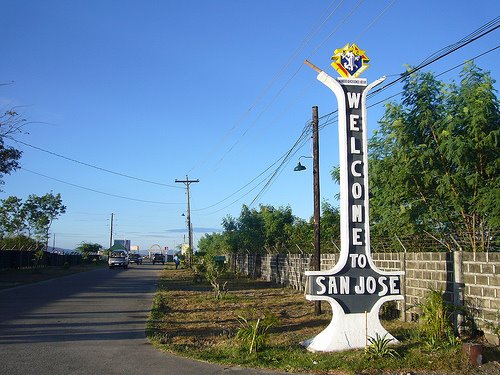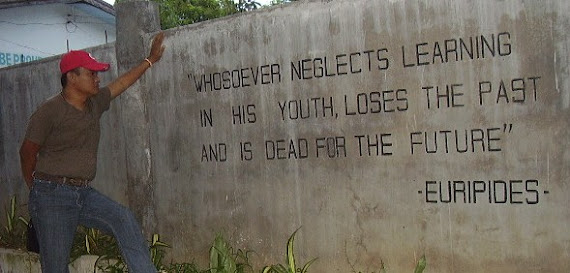Allow
me to share to you that as I grow old, the Cross to me is gradually becoming a
symbol, above all, not only of salvation but of renewal. What the people in the grassroots and
far-flung communities really aspire now is again seeing our local church
actively participating in socio-pastoral situations and realities affecting
them. My mentioning of the “Cross of Renewal” here also hinges on the belief
that we, as people of faith have to move on for a new life. Let go of the
shadows of the past, embrace the light to re-start from our tradition of
struggling with the aspiration of the masses even those who are not
church-goers (Gentiles?). Nobody can afford to just keep his fingers crossed in
the face of inhuman social and political realities in our midst till Kingdom
come!
We
cannot renew ourselves by discarding everything that we have started just
because of the ugliness of the past. This “Cross of Renewal” is challenging us
to be relevant in said context and dimension. In his book called, Called to Communion (p.142), writing as Cardinal Joseph Ratzinger,
Pope Benedict XVII taught us, “It is true
that purely spiritual attitudes also have an impact on social structures. This
shows that the spiritual element does take effect. It is necessary, yet it is
not sufficient. There is in fact a density proper to impersonal and collective
structures which has to be reached.” On the other hand, we are not suppose
to forget that the Second Plenary Council of the Philippines (PCP-II) is a
council of renewal renewing, among other things, the performance of her mission
at the service of the transformation of the Philippine society (Well for many
of us, PCP-II doesn’t ring a bell anymore). If we continue to be visible in our
Basic Christian Communities (BECs) concretely struggling with the Mangyans in
asserting their right to their ancestral domains or with the fisherfolks in
their vigilance over illegal fishing methods and the peasants against usury for
instance, we together “exalt” (rise on high) the Cross of renewal and salvation.
Call
me an old fashioned parishioner but I believe that the tenets of the almost 23-
year old Council need to be constantly revisited and revitalized. But it is sad
to note that it seems diluted into a mere event than a tool in reading the
times in the light of the Good News and “Unite
all things in Christ” (Eph 1:10) as its theme have suggested. The PCP-II
for me is always relevant to us Filipino Catholics. To some personal reminiscence,
PCP-II was the “hot” when I first set foot at the door of the Church as a lay
worker and that was 1991 until I tendered my resignation in January 2, 2011.
From a radical street militant fixed to Marx’s Dialectic Materialism, I was
able to gain example and inspiration of mainly from the Man “fixed” to the Cross.
The
decrees embodied in the PCP-II are gems of faith but it is sad to note that it
is now seldom referred to in various formation, manuscripts and homilies
addressed to the people of God. Like her social doctrine, it is becoming
another “best kept secrets” of the Church. The documents were crafted by the
Council from January 20 to February 17, 1991. The Apostolic Vicariate of San
Jose de Mindoro then is represented by Fr. Vicente C. Panaligan, Mr. Gaudencio
M. Espiritu, Sr. and the late bishop Vicente C. Manuel, SVD, DD who heads the
Conciliar Commission on the Religious. Fr. Panaligan, a jolly and friendly but
intelligent clergy was among my early mentors on how to be involved in various active
peaceful initiatives like pro-environment, the peace process and anti-illegal
gambling campaigns towards putting into action the Social Doctrine of the
Church. It’s the cross that we fearlessly put up high those days. It is the
same cross that I am trying exalt now as a government employee and as a member
of a Civil Society Organization (CSO) and as a Mindoro blogger.
Today
is September 14, Feast of the Exaltation of the Cross (or Triumph of the Cross)
and we Catholics honor the Holy Cross by which Christ redeemed the world. And
before going further, allow me to greet everyone in Sta. Cruz a Happy, Happy
Fiesta!
Here’s
a little “throwback” on the Church’s history. The public veneration of the
Cross of Christ originated in the fourth century, according to early accounts.
The miraculous discovery of the cross on September 14, 326, by Saint Helen,
mother of Constantine, while she was on a pilgrimage to Jerusalem, is the
origin of the tradition of celebrating the Feast of the Exaltation of the Cross
on this date.
As
we celebrate this feast, let us all remember Our Lord’s words, “He who does not take up his cross and
follow me is not worthy of me. He who finds his life will lose it, and he who
loses his life for my sake shall find it” (Mt 10:38,39).Meditating on these
words we unite ourselves — our souls and bodies — with the cry and aspiration
of the Anawim right here in our
diocese specially both in the rural and urban areas. We owe a preferential
option for them, remember? With this, we are worthy pilgrims who walk with
Jesus throughout history in this part of the universe.
People
would be glad seeing our local Church taking up the crosses of renewal of our
marginalized and deprived brethren by keeping alive her essential pastoral
programs that deals with seminary formation and social action ministry, among
other related programs or commissions.
The
hierarchy has to pick up the Cross of Renewal even at the point of suffering or
feeling the weight of a wounded institution brought about by our, to borrow
from PCP-II’s (665) description of the Philippines, “chronic, almost compulsive dividedness”…
-------
(Photo : Forum Andrew Gough)
-------
(Photo : Forum Andrew Gough)






No comments:
Post a Comment